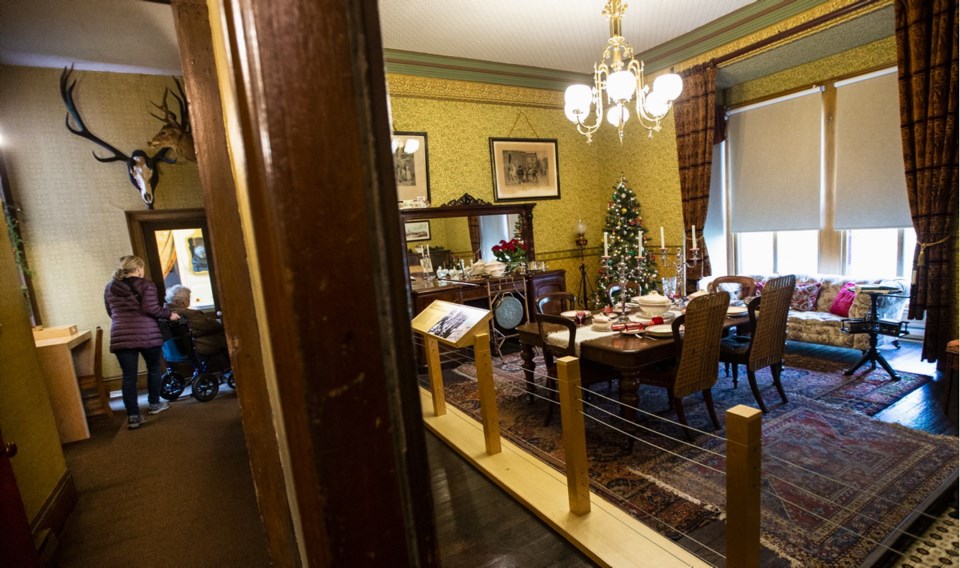A festive re-decoration of one of Victoria’s oldest homes shows how a wealthy family would have celebrated Christmas a century ago, without shying away from where that luxury came from.
Three generations of O’Reillys lived in Point Ellice House for more than a century, beginning with Peter O’Reilly, an Irish immigrant, and his wife, Caroline, from England. The couple moved into Point Ellice House in 1867 with their son Frank, the first of three children who survived to adulthood.
Both came from well-connected families, which helped O’Reilly land jobs as a gold commissioner, a magistrate, a sheriff for what was then the Colony of British Columbia and an Indian reserve commissioner.
As a reserve commissioner for 18 years, O’Reilly actively participated in the colonization of Indigenous people, establishing more than 600 reserves across the province without treaties or adequate consultation.
“We want people to think about how this lifestyle was created, which, of course, was based on the diversion of resources from Indigenous peoples to settlers. So that’s an important part of what we’re trying to display here. And not just trying to show happy Christmas,” said volunteer and board member Misao Dean.
O’Reilly worked as reserve commissioner from 1880 to 1898, but Dean said his actions aren’t excused because he lived during a different time. She points out that the reserve commissioner before him publicly criticized the government’s lack of consultation with Indigenous peoples. O’Reilly moved into the position after Gilbert Sproat resigned from the role.
“So we can’t think that all the settler people were the same. It was possible to fight against some of these bad things that were going on in those days. And some people did,” said Dean, who is also an English professor at the University of Victoria, specializing in early Canadian writing.
The wealth O’Reilly accumulated in his respected government role gave the upper-class family a life of luxury. They enjoyed frequent trips to Europe, and the children were educated in England.
Despite their wealth, the family’s Christmas looks a lot like celebrations today, minus Santa Claus and his crew of elves and reindeer.
Dean said the house is set in a time — around the late 19th century — when modern Christmas celebrations were starting to take shape. Shops in downtown Victoria stores would have been decorated for the holiday, and the family would have exchanged small gifts, although the focus would have been on family and Christianity.
A decorated Christmas tree stands in one corner of the dining room, where the O’Reilly family would have kept it, as seen in family photos on display. Sheet music for Silver Bells waits at the piano, and Christmas crackers that would have been homemade mark each setting at the table, along with fine china.
The family would likely have enjoyed a Christmas dinner of turkey, stuffing, mince meat and brown cake — similar to a fruit cake — for dessert. Handwritten recipes for some of the family’s Christmas specialities are on display in the kitchen, with modern instructions added. They’re also for sale in the museum’s gift shop.
Christmas cards received by the O’Reilly family favour flowers and religious motifs over winter scenes and images of Santa Claus.
The house passed down through three generations of O’Reilly men, before John O’Reilly — the grandson of Peter and Caroline — sold the house to the provincial government in 1974.
The Vancouver Island Local History Society took over management of the heritage house in March. Dean said the non-profit has brought significant changes to the way the family’s history is depicted.
The gift shop sells books about reconciliation and by Indigenous writers, and an exhibit called the Politics of Luxury discusses O’Reilly’s work and his role in colonialism. “We want people to enjoy themselves here, but we also want them to think,” Dean said. “[O’Reilly] was part of the overall mission of the settlers, which was to relieve the Indigenous people of their lands and to put them to use in the service of the British Empire.”
regan-elliott@timescolonist.com
• The Christmas display at Point Ellice House, 2616 Pleasant St., is open on Saturdays and Sundays until Dec. 22 from 12 to 4 p.m.



